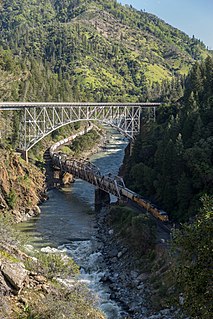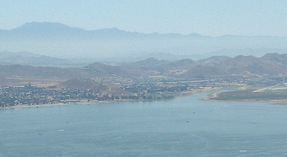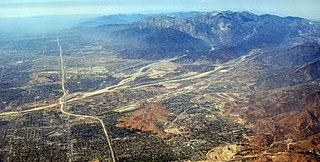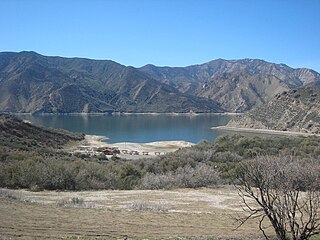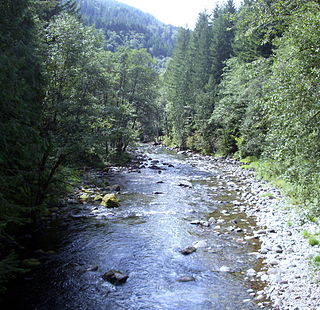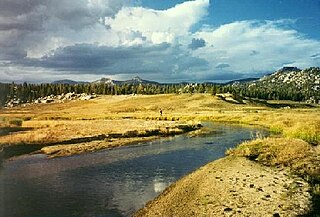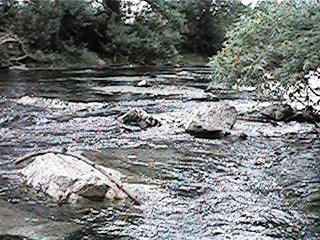| City Creek | |
| River | |
The nearly-dry bed of City Creek near Highland, California | |
| Country | United States |
|---|---|
| State | California |
| Region | San Bernardino County |
| Part of | Santa Ana River |
| Tributaries | |
| - left | East Fork City Creek |
| - right | West Fork City Creek |
| City | Highland |
| Source | Confluence of East and West Forks |
| - elevation | 2,280 ft (695 m) |
| - coordinates | 34°17′33″N117°18′22″W / 34.29250°N 117.30611°W [1] |
| Mouth | Santa Ana River |
| - location | East of San Bernardino International Airport |
| - elevation | 1,037 ft (316 m) [1] |
| - coordinates | 34°09′55″N117°21′43″W / 34.16528°N 117.36194°W Coordinates: 34°09′55″N117°21′43″W / 34.16528°N 117.36194°W [1] |
| Length | 7.5 mi (12 km), North-south |
| Basin | 19.6 sq mi (51 km2) [2] |
| Discharge | |
| - average | 10.1 cu ft/s (0 m3/s) [2] |
| - max | 7,000 cu ft/s (198 m3/s) |
| - min | 2.6 cu ft/s (0 m3/s) |
City Creek is a 7.5-mile (12.1 km) tributary of the Santa Ana River in western San Bernardino County in the U.S. state of California. Its watershed drains about 19.6 square miles (51 km2) on the southwest slopes of the San Bernardino Mountains. Although short, the creek stretches about 12 miles (19 km) to its farthest source.

The Santa Ana River is the largest river entirely within Southern California in the United States. It rises in the San Bernardino Mountains and flows for most of its length through San Bernardino and Riverside Counties, before cutting through the northern Santa Ana Mountains via Santa Ana Canyon and flowing southwest through urban Orange County to drain into the Pacific Ocean. The Santa Ana River is 96 miles (154 km) long, and its drainage basin is 2,650 square miles (6,900 km2) in size.

San Bernardino County, officially the County of San Bernardino, is a county located in the southern portion of the U.S. state of California, and is located within the Greater Los Angeles area. As of the 2010 U.S. Census, the population was 2,035,210, making it the fifth-most populous county in California, and the 12th-most populous in the United States. The county seat is San Bernardino.

In the United States, a state is a constituent political entity, of which there are currently 50. Bound together in a political union, each state holds governmental jurisdiction over a separate and defined geographic territory and shares its sovereignty with the federal government. Due to this shared sovereignty, Americans are citizens both of the federal republic and of the state in which they reside. State citizenship and residency are flexible, and no government approval is required to move between states, except for persons restricted by certain types of court orders. Four states use the term commonwealth rather than state in their full official names.
It rises in two forks of similar length and size, West Fork City Creek and East Fork City Creek, in the San Bernardino National Forest. Both forks begin on the crest of the San Bernardino Mountains. The West Fork rises near Crest Summit south of the unincorporated community of Crest Park, at about 5,400 feet (1,600 m). It flows south then southeast and finally south again through multiple gorges, picking up several unnamed tributaries. The East Fork begins in a fan-shaped group of gulches south of Heaps Peak and Mount Sorenson, at about 6,000 feet (1,800 m). From there it runs south-southwest in a canyon past Fredalba, receiving Schenk Creek from the left near the mouth. The West Fork is about 4 miles (6.4 km) long; the East Fork stretches roughly 3 miles (4.8 km).

The San Bernardino National Forest is a United States National Forest in Southern California encompassing 823,816 acres (3,333.87 km2) of which 677,982 acres (2,743.70 km2) are federal. The forest is made up of two main divisions, the eastern portion of the San Gabriel Mountains and the San Bernardino Mountains on the easternmost of the Transverse Ranges, and the San Jacinto and Santa Rosa Mountains on the northernmost of the Peninsular Ranges. Elevations range from 2,000 to 11,499 feet. The forest includes seven wilderness areas: San Gorgonio, Cucamonga, San Jacinto, South Fork San Jacinto, Santa Rosa, Cahuilla Mountain and Bighorn Mountain. Forest headquarters are located in the city of San Bernardino. There are district offices in Lytle Creek, Idyllwild, and Fawnskin.

Crest Park is an unincorporated community in San Bernardino County, California, United States. Crest Park is located in the San Bernardino Mountains on California State Route 18 1 mile (1.6 km) south of Lake Arrowhead. Crest Park had a post office with ZIP code 92326, which opened in 1949.
The two forks combine in a steep chasm just downstream of where the West Fork passes under a bridge of California State Route 330, also known as City Creek road. The main stem flows south in a thousand-foot-deep gorge between McKinley and Harrison Mountains, rapidly dropping to the plains near Highland, where most of its flow is diverted into canals for municipal and agricultural usage. Downstream of the diversions the creek fans out into alluvial deposits. Cook, Bledsoe and Elder Gulches as well as Plunge Creek all enter from the left as the creek flows along the east side of Highland in a wide flood control channel. It joins the Santa Ana River to the southeast of San Bernardino International Airport.

State Route 330 is a state highway in the U.S. state of California. It is also known as City Creek Road in the San Bernardino Mountains.
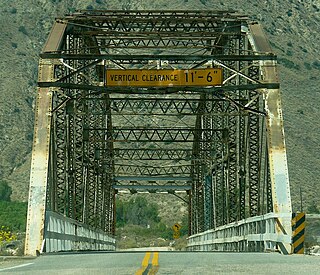
Highland is a city in San Bernardino County, California, United States. The population in 2010 was 53,104, up from 44,605 at the 2000 census. The term Highland also refers to a geographical area of the city of San Bernardino, and parts of unincorporated San Bernardino County. Highland is generally divided into two regions, East Highland and Highland
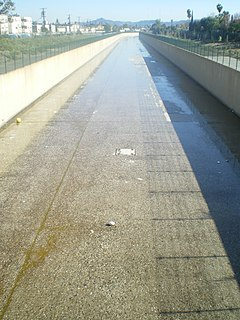
Flood control channels are large and empty basins which let water flow in and out or dry channels that run below the street levels of some larger cities, so that if and when a flood occurs, the water will run into these channels, and eventually drain into a river or other body of water. Flood channels are sometimes built on the former courses of waterways as a way to reduce flooding.


